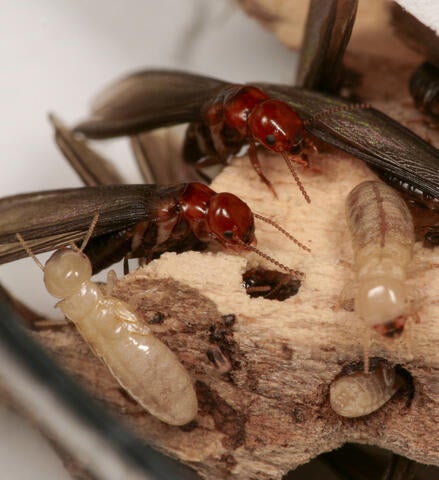2024-05-31 カリフォルニア大学リバーサイド校(UCR)

Western drywood termites. (Dong-Hwan Choe/UCR)
<関連情報>
- https://news.ucr.edu/articles/2024/05/31/greener-more-effective-way-kill-termites
- https://academic.oup.com/jee/advance-article-abstract/doi/10.1093/jee/toae101/7675403
西洋乾材シロアリ(Blattodea: Kalotermitidae)を標的とした局所的殺虫剤注入を改善するためのピネン類の利用可能性 Potential use of pinenes to improve localized insecticide injections targeting the western drywood termite (Blattodea: Kalotermitidae)
Nicholas A Poulos, Chow-Yang Lee, Michael K Rust, Dong-Hwan Choe
Journal of Economic Entomology Published:16 May 2024
DOI:https://doi.org/10.1093/jee/toae101
Abstract
The western drywood termite, Incisitermes minor (Hagen), causes significant economic damage to wood structures in the United States of America, especially California. When infestation is not widespread, localized insecticide injections may be useful for remedial control. However, the extensive gallery structure of drywood termites and their tendency to aggregate at specific parts of the galleries can impact the efficacy of localized insecticide injection. Chemicals that attract termites from a distance may improve the localized insecticide injection by increasing the number of termites contacting the insecticide residues. Two volatile terpenes, α-pinene and β-pinene, commonly found in many coniferous timber trees, were applied to artificial termite galleries to determine if termites were attracted from their original aggregation site. Furthermore, we examined if adding these pinenes would improve the overall efficacy of some insecticide products for drywood termite control. Behavioral assay results showed that the treatment with pinenes increased the likelihood that drywood termites would leave their original aggregation site and contact the treated part of the gallery. When tested with the pesticide products applied in a small area away from the termite aggregation, β-pinene significantly accelerated the time course of mortality for the aqueous fipronil. The efficacy of disodium octaborate tetrahydrate dust was not influenced by the addition of pinenes. Implications for drywood termite management and future research directions are discussed.



